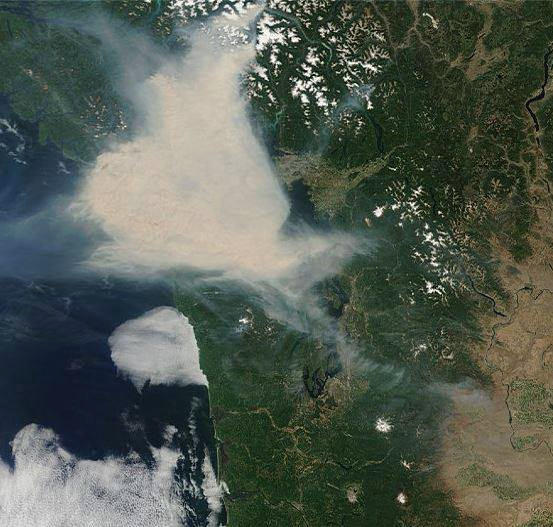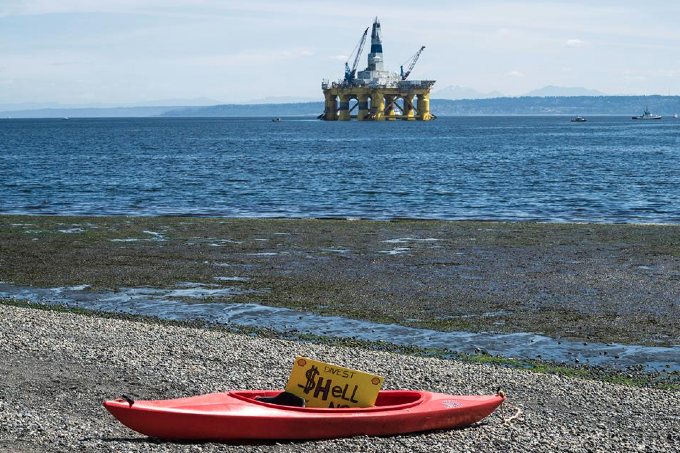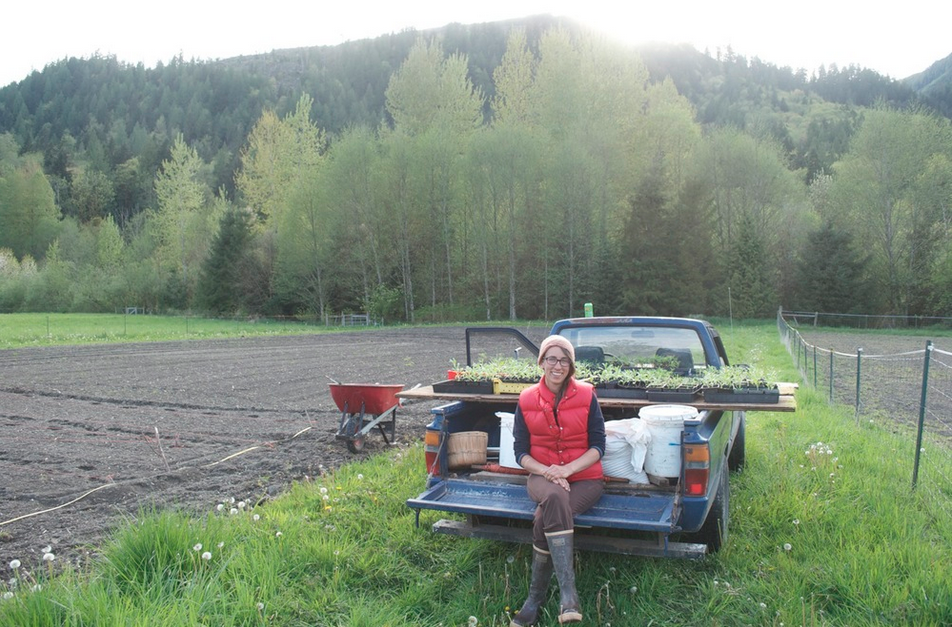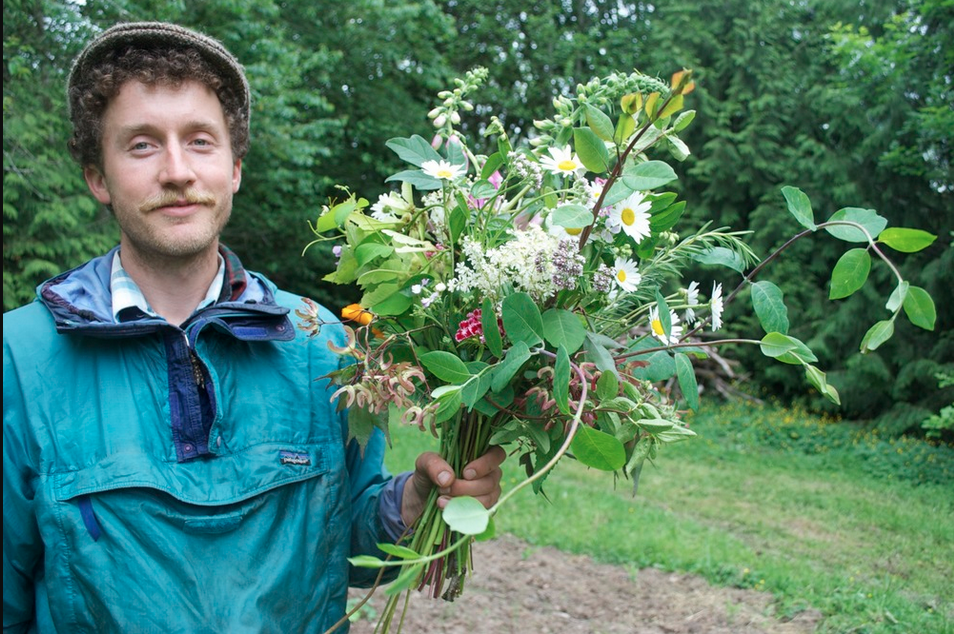Brown Haze… Cough, cough, cough…
July 9th, 2015
 Image Courtesy of the National Weather Service
Image Courtesy of the National Weather Service
Post contributed by Christine St. Pierre
During this incredibly dry, hot summer, brown is the new green for forests, gardens, and fields in the Pacific Northwest. Wildfires are ravaging parts of Canada and patches of Washington state, leaving the whole of the upper left—and other northern parts of the country—choking on its smoke.
Considering the incredible drought and an apocalyptic conflict over water rights in California, it comes as no surprise that Washington, Idaho, Oregon, California, and Western Canada are also experiencing hotter-than-usual temperatures. But, wildfires in the wettest region of the country have many on alert, wondering what this could mean for the future in regards to climate change. Following an unusually dry winter with miniscule snowfall in Washington’s famous ski destination, Mt. Baker, these traveling wildfires are cause for alarm.
In Canada, tens of thousands of acres are burning, from the dry, flat central provinces of Manitoba and Saskatchewan (north of Minnesota and North Dakota) to British Columbia. Currently, urgent evacuations are underway in Saskatchewan. Many U.S. citizens have posted photos of a smoky haze over the Twin Cities of St. Paul and Minneapolis, triggering air quality alerts that urge limitation of outdoor activities, particularly for those affected by smoke or other contaminants in the air, particularly the very young and elderly. In Washington, the smoke has reached as far south as Vancouver, just north of the Oregon border.
According to Canadian officials, nearly 90 wildfires are currently being battled in British Columbia alone, claiming 77 square miles of Whistler, best known for its legendary skiing and snowboarding. In Washington and Oregon, firefighters are working to contain 21 wildfires. The “Paradise Fire” continues to rage on in the Olympic National Park, with many others scattered across the state. Recently, an increase in fires follows Fourth of July fireworks shows, particularly for Lake Whatcom in Bellingham, where a small fire continues its slow march. Spontaneous fires reported along I-5 in the Seattle area are thought to have been caused by cigarette butts.
This summer, do you part in minimizing the potential spread of wildfire in our normally luscious Pacific Northwest. Refrain from using fireworks, setting fires near the wilderness (particularly with dry leaves), and have your vehicles checked for functioning spark arresters before heading into the forests. Now would be a great time to consider cutting the habit of smoking, or get in the habit of throwing your cigarette butts in the garbage. It’s our responsibility to prevent human-caused wildfires! Be sure to report alarming and potentially hazardous behavior to local authorities.
“Shell No” – One Activist’s Views
July 2nd, 2015

By Christine St. Pierre Photo by Linda Wolf
“Don’t like Shell’s ice cold views on global warming?” “How much does a polar bear weigh? Enough to break the ice!” “You seem like you enjoy vacationing on the beach. Save the beaches!” “Does your little one love snacking on fish sticks?” “Ever seen Waterworld? Let’s make sure that doesn’t become our reality.”
Years ago, I used dozens of these catchy, shallow one-liners to draw peoples’ attention to me, the 5’ 3’’ Greenpeace canvasser standing in the pouring rain on 4th and Pike with a clipboard and the determination to get you to join the ranks of others who wish to keep Shell out of the arctic. In a perfect world, I could have looked you in the eyes, reached my hand in your direction, and said, “Shell oil plans to drill for fossil fuels in one of the most wild, hostile environments on Earth,” or, “One isolated oil spill endangers the Indigenous communities and species thriving in the arctic ocean, as well as the entire planet,” or maybe, as actress and activist Jane Fonda recently pleaded at a rally in Seattle, “This is the fight of our lives.”
But the world is not perfect, and, statistically, using corny one-liners provokes you to stop and talk with people like me much more frequently then us shouting, “Did you know 13% of the planet’s undiscovered oil is thought to rest beneath the Arctic Ocean? Seems like a lot! But at our current rate, that’s only three years of consumption! Is that worth irreversible environmental devastation?”
Why? Because you don’t want to be bummed out, confronted, shocked—because you’re on vacation or a quick lunch break or you would rather go home and research this issue on your own. More often than not, you’ll keep walking, shouting an apology that grows fainter with every footstep. And, more often than not, you won’t research more at home. You’ll forget about what I said, why I was standing there. But eventually, inevitably, we’ll find ourselves standing side-by-side on the frontlines of one of the most threatening capitalist schemes in human history.
The movement didn’t start with Greenpeace or me or you; it has been happening for decades: we the people are silenced while fossil fuel lobbyists and greedy politicians shake hands in the crooked corridors of DC, sending fleets of oil rigs into heavily populated, pristine environments, causing massive disasters like the 1989 Exxon Valdez oil spill in Alaska or the 2010 BP Deepwater Horizon spill in the Gulf of Mexico. Many don’t believe their voices can be heard by the fossil fuel mafia or politicians who are positioned to hear our cries—that one person can’t make a difference. But if everyone believes that, then there is no movement—only surrender.
In 2013, provoked by massive people power, the federal government barred Shell from drilling in the Chukchi Sea following a series of accidents during exploratory drilling in 2012, i.e. Shell’s drilling rig Kulluk running aground off the coast of Alaska. The U.S. Coast Guard blamed this embarrassing uh-oh on “inadequate management and assessment of risks” in icy, storm-tossed waters, according to its final report on the accident. News spread about the operating rig pleading guilty to eight felony offenses and paying $12.2 million over falsifying records that would prove the oil rig outdated and unfit for such demanding conditions. Shell temporarily halted the project, and many of Shell’s executive staff publicly expressed doubts about the low financial reward of such a high-risk operation, which is why many were outraged at the Obama Administration for allowing Shell (of all companies) to drill for oil off of the Alaskan coast this year.
Aside from threatening the food supply and livelihood of the four-million people living in the arctic, many of whom, like the Inupiat, are Indigenous communities, along with the seventeen whale species, thousands of migrating birds, endangered polar bears and stellar sea lions, and other life depending on this delicate ecosystem, here’s why we should all be concerned:
• The area is extremely remote, with manic weather, icy waters, hurricane-force storms, sub-zero temperatures, endless winter darkness, and waves up to 50 feet in height. There are no service roads or deepwater ports for hundreds of miles, delaying rapid rescue and cleanup when (not if) an accident occurs. The closest Coast Guard equipped for responding to oil spills is stationed 1,000 miles away.
• It took BP three months to control its ruptured well in the Gulf of Mexico. A cleanup in the drilling areas in the Chukchi and Beaufort Seas boasts entirely different obstacles. The aforementioned extreme conditions threaten to prevent rescue access, freeze cranes, and deem oil dispersant chemicals useless.
• And then there’s the ice. A spill, detected or undetected, could spread beneath the surface of the ocean, traveling beneath ice flows hundreds of miles. There is potential for ice to become frozen in the oil within just four hours of exposure, where it could remain until the ice melts, whenever that may be.
• The successful drilling of vital relief wells, necessary for capping a ruptured well, could not be guaranteed in the drilling season’s few summer months before winter ice—and towering icebergs—returns.
• Shell claims it can clean up to 95% of spilled ice, a fantastical statistic considering the relative Exxon Valdez spill in Alaska which cleaned 9% of oil in 1989 and BP’s mere 17% in 2010. According to the US Geological Survey, 1-20% of Beaufort/Chukchi oil could be recovered.
Amidst a global movement to wean off of fossil fuels and redirect our focus on green and clean energy sources, a push to drill in hazardous, fragile waters for a small portion of energy is a giant setback. Recently, Seattle Mayor Ed Murray stood with activists and kayactivists amidst the port city’s positionality in the eye of the storm, “To prevent the full force of climate change, it’s time to turn the pages on things like coal trains, oil trains and oil drilling rigs. Its time to focus the economy on the future: electric cars and transit, green homes and environmentally progressive businesses.” The mayor and many Pacific Northwesterners have held strong in opposition against the presence and portage of Shell’s Arctic Fleet, including the drill rig Polar Pioneer. Folks have climbed it, blockaded it, and created a human flotilla in its path, but the fleet as begun its journey to Alaska.
Secretary of the Interior Ken Salazar has received hundreds of thousands of phone calls from people like you and me over many years of persistence opposition. The Obama administration has received letters written by entire nations, unions, organizations, and individuals pleading for a ban on arctic oil drilling. We’ve seen what people power can do: so far, we have succeeded in pushing the Obama administration to block the Keystone XL pipeline and create stronger regulations for coal-fired power plants. It’s not too late to match your voice with the countless others who can no longer sit idle while one of the last remaining frontiers of the Far North is plundered for money. Start by signing one or all of the online petitions linked below.
Stop Shell’s Dangerous Offshore Drilling Exploration in the Arctic

Peace and quiet enveloped me as I leaned against the doorframe of Sadie Beauregard and Paul D’Agnolo’s wooden yurt, one leg draped over the balcony’s edge, gazing down at the blueberry, raspberry, thimbleberry, and salmonberry bushes that the three of us had just harvested for the pie we would soon eat with their sweet neighbor Margot, a seventy year-old member of River Farm, an intentional community and cooperative farm located in Van Zandt, Washington. The two moved from farms on Bainbridge Island to the River Farm in December to begin a farm operation of their own, Foothills Flowers Farm—a far-off dream for so many.
Looking east from my perch in their elevated yurt, I took in a view of the Twin Sisters peaking over the forested foothills of the North Cascades, a beautiful backdrop to the resilient permaculture that the stewards of this Evergreen Land Trust have nurtured since a group of anarchists from Capitol Hill began the intentional community decades ago. Various walnut, apple, cherry, and plum trees provided shade for the rambunctious piglets romping around their grassy pasture. In the distance, the north fork of the Nooksack River carved along the property’s edge, encompassing the many small households, garden plots, pastures, trails, and groves within this Van Zandt paradise.
Seeking refuge from the early evening’s thick summer air, the three of us sat indoors, surrounded by textured bouquets of native flowers grown by the couple just a few hundred feet away, to be sold at various farmers markets. A John Prine record spun through the airwaves while we slow-cooked a blueberry and garlic scape-soaked salmon from the nearby rushing river, caught and gifted by a neighbor on the farm. This cooperative “what’s mine is yours” mentality is one of the many progressive concepts that drew Sadie and Paul into the sustainable farming community at various points in their life history.
The couple’s stories converged on Bainbridge Island while working for various farms and transformed into a shared desire to make the dream a reality: start a farming business, live sustainably, strengthen the farming community, and, ultimately, help to heal an ailing food system.

Paul, a Minnesotan, was turned off by his local farming community’s endless monocrop chemical agriculture that dominated the landscape, eventually farming on an island in Vermont’s Lake Champlain following a summer in Alaska. After an internship at Milwaulkee’s Growing Power, Paul traveled to California to work in the mountains looking for specific plants, eventually finding a home in Washington. Once in the Pacific Northwest, Paul wrote to his siblings in Minnesota, urging them to “quit their jobs, move west, buy a farm, climb mountains, catch fish, and be a family!” Within a year, the siblings were reunited, and five years later they continue to thrive. Paul expanded his farming experience, working at Seattle Tilth Farm Works in Auburn before eventually moving to the island to work with Symbiosis Food Cart and Bainbridge Island Farms, later moving to Butler Green. There, he met his “sweet Sadie beau” who has “been key in keeping [their] wandering way aligned with [their] hopes and aspirations toward owning a farm operation.”
Sweet Sadie, a moniker that so fully encompasses her tender nature, is a Vashon Island native who began this work five years ago after falling in love with farming during a year of urban gardening with AmeriCorps*VISTA in Seattle. After her service, Sadie took an internship at a small vegetable farm on San Juan Island, feeling like she “could farm forever.” She, like Paul, savors “the physical, hands-on nature of farming, as well as the opportunity to be outside and think creatively about growing, harvesting, and marketing.” Following her internship, Sadie was hired on at the island’s Persephone Farm where she “found flowers,” and flowers found her. There, she came to realize the importance and value of local flowers, seeing them akin to local food in that “conventional flowers are often grown with heavy chemicals by workers with poor working conditions and shipped hundreds of miles.” Eventually, her island farming career led her to work with both Heyday Farm and Butler Green, where she met Paul and found her best friend, a partner to build a farm with, to cook, hike, and laugh with “at all of the mistakes and triumphs we make along the way.”
With Paul’s brother operating Small Acres Farm nearby their now budding flower farm, Foothills Flowers, Paul and Sadie were able to partner their CSA operations for broader outreach. They have secured stands at the Fairhaven Farmer’s Market in Bellingham on Wednesdays, the Lynden market on Thursdays, and the Twin Sisters Market, which was created by fewer than ten local farms operated by young sustainable farmers, including Foothills Flowers.
This cooperative attitude is the tie that binds the farming community together. “We’re all broke, tired, struggling—but that’s what needs to change: the competitive attitude between farmers needs to turn into a cooperative one,” explained Paul. “The glimmers of light are where you and your buddies can help each other out—you can have a market where you don’t need to be there every week, or land you don’t need to own, and you can teach each other and share your secrets.”
Leaning against the open doorway across from me, Paul briefly paused, looking out across his garden. “Our food system is broken and we don’t have enough farmers to fix it.” This sharing of knowledge creates an important dialogue and helps strengthen community in a big way. Being at markets and conversing with your community about growing sustainably builds autonomy and excitement, and not just between farmers, causing everyone to care more about their natural surroundings.
Foothills Flowers Farm is built upon this appreciation and sense of place in life. The focus is on what bouquets do to you when you’re around them. “What I like about floriculture is that it really connects you to the season and makes you notice native plants with distinct flowers,” explained Paul, who described the bouquets produced by their farm as native flowers that are appropriate for climate and seasons, incorporating perennials, greenery, vines, and grasses to add texture. “They make you look at every plant and think, ‘How beautiful is that plant? Can we add that to a bouquet? Would we be able to make others see its beauty, too?’”
The answer is yes. Their unique and nontraditional flower arrangements are simple and breathtaking, featuring sweet pea, lupin, millet, wild rose, and thimbleberry blossoms, to name a few. Following a grant from the Bellingham Food Cooperative, which was used for marketing, supplies, insurance, and a rental truck arrangement with Cloud Mountain, another cooperative farm nearby, the two have taken Foothills Flowers to new, bold heights. Their success has stemmed from intense community support and the necessity for a healthier, stronger farming culture. Support your farmers, know your farmers—visit foothillsflowersfarm.com for more information about offers on events, weddings, and Sadie & Paul’s mission.
Contributed by Christine St. Pierre